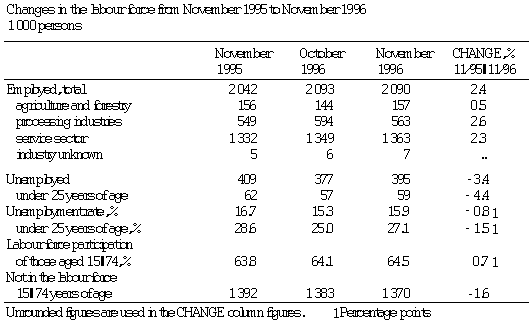31 December 1996
Continued improvement in employment in November
The service sector and the processing industries saw an increase in jobs from November 1995 to November 1996, as indicated by the Labour Force Survey of Statistics Finland. Agriculture and forestry remained at last year's level. All in all jobs increased by almost 50 000 in one year.There was a rise in men's jobs while women's jobs remained at the same level as last year. The seasonally adjusted employment was up by about five thousand from October to November.
The number of unemployed totalled 395 000 persons in November, being 14 000 less than a year ago. Men accounted for 199 000 of the unemployed and women for 196 000. The seasonally adjusted unemployment fell by two thousand from October.
The unemployment rate in November was 15.9 per cent, which is 0.8 percentage points lower than the year before. The unemployment rate of men was down by 2 percentage points to 15.1 per cent whereas that of women was up by 0.6 percentage points to 16.8 per cent. There were 59 000 unemployed young people, which is slightly less than the year before. A total of 104 000 of the unemployed had been employed in services in the public sector and other services while 55 000 had been employed in industry. The highest unemployment rate was in construction, amounting to 29.3 per cent.

Revised Labour Force Survey, first results in early March
The monthly Labour Force Survey of Statistics Finland will be revised. The first results of the new Labour Force Survey will cover January 1997 and will be released during the first week of March.
The contents of the survey will be broader. Definitions will be modified so that they better correspond to international recommendations. The monthly survey, carried out at Statistics Finland each spring since 1995, will also be harmonised with the labour force survey of the European Union.
New information will be available on atypical work, such as fixed-term contracts and part-time work as well as on atypical entrepreneur-ship and new job contracts. Data on the duration of unemployment, underemployment and disguised unemployment are also new featu-res. More versatile information will likewise be available on jobseeking.
Since different types of atypical jobs will henceforth be better described in the statistics, the new statistical system will generate higher figures for employment. The change in the definition will also cause an increase in the employment figures since those laid off for a fixed term will be classified as employed whereas in the older system they were classified as unemployed.
The Finnish national practice in measuring unemployment still deviates to some extent from that of the ILO recommendation, according to which the unemployed must have been actively searching for work in the preceding four weeks. This condition is interpreted more broadly in Finland because the registration intervals for the unemployed are exceptionally far between in Finland. Those registered at the labour exchange office are classified as active job seekers if they have reported to the office in the past six months. A change on earlier practice is that the general unemployment classification principles will henceforth be applied to students and those laid off.
Source: Labour Force Survey, November 1996. Statistics
Finland
Inquiries: Mr Tapio Oksanen, tel.+358 9 1734 3228 or Mr. Hannu
Siitonen,
tel. +358 9 1734 3225
